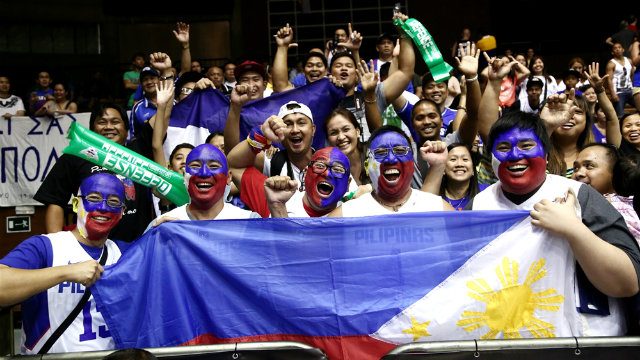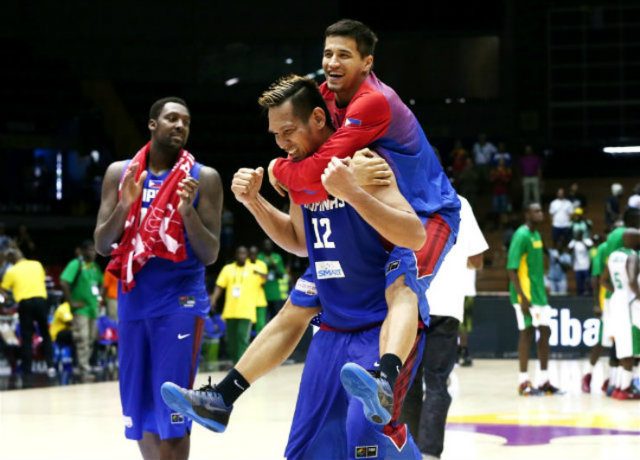SUMMARY
This is AI generated summarization, which may have errors. For context, always refer to the full article.

MANILA, Philippines – A few days back, as I was trying to miraculously make the AC in my Honda Civic go colder than it’s mechanically permitted to in the scorching afternoon heat of downtown Manila, I looked outside my window and saw a sight I’ve spotted countless of instances throughout the 22 years of my existence in this country.
With sweat pouring from their faces and without any footwear between them and the concrete, young Pinoy kids – they must have been around 9-11 years-old – dribbled what looked like a basketball years beyond its virility and repeatedly threw up shots against a rim on what barely resembled a court.
Nevermind that they would surely have blisters on their feet after playing or that the chances of making a shot was drastically low due to the wrongly-angled metal stick that was bent to play the part of a rim, pinned against what was an extremely old pieced of rectangular wood.
Nevermind that they had to stop playing every two minutes whenever a car would pass by, as the vehicle took away the 15-foot gap from one side of the street to the other that was their version of a hardwood floor.
The pure joy and ecstasy on these kids’ faces could lift anyone up. For a moment, I forgot that my phone kept buzzing with messages from work or that the Toyota Vios behind me was honking its horn, screaming for me to move forward.
I see it almost every day actually – a similar scene takes place on the street where my dad’s office is. But regardless of when or where you notice such a scenario – whether for the first time or the 100th – it just never ceases to amaze.
A few hours later, as I scrambled to find cellular data near courtside at the San Juan Arena to e-mail my game report, I looked to my right and saw arena bouncers and staff participating in a game of halfcourt 4-on-4. Later on, members of the media joined them. When another staff member came out of the dugouts with another ball, those who were erstwhile watching from the sidelines formed their own teams and had their own game.
For brief moments, I forgot what I was doing and just watched. It was so simple, yet it felt so surreal. And it actually happens all the time.
Basketball will always be king in the Philippines.
We bask in the glory and success of Manny Pacquiao and the many other great boxers who have – and will continue – to achieve success in the international stage. We love our Azkals for bringing pride to football in our nation. Our volleyball national team are our darlings, and we always make it a point to take pride in how important a role the sport plays here even if it is significantly less popular in other areas of the world.

But basketball is the Philippines’ greatest sporting love. There’s something about it that feels like home. It’s similar to when you go out of town for a few days, maybe even stay in a fancy 5-star hotel room that overlooks a beautiful beach of a beautiful island, but a part inside of you still craves for your own bed, your own living room, your own home-cooked meals.
That’s no disrespect to the other aforementioned sports that are absolutely special in their own rights. But it makes sense. England has football. India has cricket. Australia has rugby. We have basketball. It feels like home in our country, and in four years, our country has an opportunity to host the grandest, most extravagant basketball tournament in the world.
According to a report released by FIBA in March, the Philippines and China remain as the frontrunnners to land hosting rights to the World Cup. Let’s all be real: the competition is tough. China has yet to host the World Cup, but they have hosted a much bigger tournament: the Olympics in 2008. I haven’t seen their facilities, but they’re likely more state-of-the-art.
Their cities are bigger. Over the past years, it’s become a hotbed for global markers – take Nike, for example, which has sent guys like Kobe Bryant and LeBron James there more than once.
Does that put the Philippines at a disadvantage? Should China be considered the favorite? Not so fast. Our country has its own merits.
They need arenas to play in? Well, there’s the 52,000-seater Philippine Arena, which has already hosted the opening of the PBA’s 40th season, and, heck, even a Katy Perry concert.
There’s the Mall of Asia Arena, which hosted all games of the 2013 FIBA-Asia Championship and the 2013 NBA Global Games when the Indiana Pacers and Houston Rockets came to town for a preseason game.
There’s Araneta Coliseum, which might not be as aesthetically pleasing as the two aforementioned stadiums, but has enough history to write a book: from the Thrilla in Manila, to the 1978 World Basketball Championship (FIBA World Cup), to WWE events, and even the Smart Ultimate All-Star Weekend in 2011, when NBA players like Bryant, Chris Paul, Kevin Durant, and Derrick Rose, among others, came to town.
Hotel accommodations? I’m certain the 5-star accommodations of Shangri-La, The Marriott Hotel, Intercontinental Hotel, or Sofitel would be up to task. Telecommunications? They’re not perfect, but Globe and Smart are more than viable.
“The ingredients are there, between Mr. Pangilinan, his own network, and the people in the federation, but also the network outside the federation to bring all this somehow together,” FIBA Secretary General Patrick Baumann said when the FIBAEvaluation Commission inspected the Philippines in January.
“The team has seen all of the facilities that could be part of the overall story of the World Cup here. They’ve seen the venues. They’ve seen the [Philippine Arena] – 52,000 spectators capacity. They’ve seen the Mall of Asia [Arena]. They’ve seen the plans for two venues that would be very good venus to come. They’ve seen the historical piece of venue that is the Araneta [Coliseum], which hosted the World Cup already – World Championship in 1978… it is a really important piece of history.”
I’ll leave comparing the advantages of hosting the 2019 World Cup in the Philippines or China – a decision to be made after final bids are presented in August – up to FIBA, but here’s one more note I have to mention, and that is one asset I believe the Philippines has over China: Puso (heart).
Puso has become a cultural mantra in this country to represent fighting pride and honor of our national basketball team in international play. It fits, especially considering that Filipinos usually go up against taller and more superior athletes in FIBA tournaments. But puso is more that just what we see our national team display when they hustle for loose balls or try to rebound against 7-foot basketball behemoths from Senegal or Puerto Rico.
Puso represents the love and passion that this country has for the game of basketball.
Puso is kids fighting against Manila’s unforgivable heat just to play a game of 3-on-3 so that their dreams of becoming the next James Yap or Mark Caguioa lives another day.
Puso is 30, 40-year old arena bouncers and staff spending an hour more just to play the game they love despite standing on their feet during work duty for the entire day.
Puso is taxi drivers, waiters, commuters, and many others sacrificing minutes of their working hours, staying outside a sports bar, and crowding a portion of a street, just to catch a glimpse of the conclusion to Game 3 of the NBA Finals between the Cleveland Cavaliers and Golden State Warriors; to see what kind of heroics “idol” LeBron James or Steph Curry has in store.
Puso is hundreds of Ginebra or Purefoods fans waiting for an hour or two after the game outside the MOA Arena or Araneta Coliseum – heck, even the old Cuneta Astrodome – to catch a wave or smile from PJ Simon, Japeth Aguilar Greg Slaughter, Mark Barroca, or any other Hotshot and Gin King. Imagine if LeBron or Pau Gasol were here.
Puso is thousands of Filipinos across the world going to bed with hears broken, tears dropping from their eyes, in the wee hours of the morning after watching Gilas unable to convert a glorious opportunity to grab their first win in the World Cup in 40 years against Argentina.
Puso is, a few days later, when Jimmy Alapag hits a 3-pointer down the stretch of overtime, and Filipinos start to tear up again after realizing that, finally, after 40 years, they’re about to gain their first win in the World Cup against Senegal.
Puso is strangers at the MOA Arena who have never met each hugging each other in celebration after the curse of Korea was broken by an injured Marcus Douthit-less Gilas in the FIBA Asia Championship – a day in August 2013 that many will never, ever forget.
“What should I say? Puso,” said FIBA Evaluation Commission Chairman Lubomir Kotleba in January. “It’s known that puso is not only in the arena; puso is everywhere.”
“We saw the puso everywhere we [went].”
(READ: Gilas Pilipinas shows the world what ‘puso’ means)
“I think that it is a pleasure for the FIBA family to see the Philippines back this level, the international level,” Baumann said.
“This is a country that wants to grow, wants to develop, not only in basketball, but in the many areas of society across the country and clearly it does have the ambition to be at the top in our sport.”
We know how special basketball is to our country. FIBA knows it.
The rest of the world should know it too.
– Rappler.com
Add a comment
How does this make you feel?
There are no comments yet. Add your comment to start the conversation.